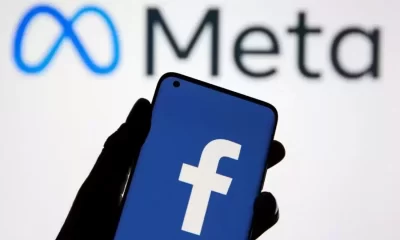Business
Facebook Owner Meta Axes Another 10,000 Jobs

On Tuesday, Facebook owner Meta announced a new round of layoffs as part of the company’s “year of efficiency,” as the US tech sector continues to contract due to Biden inflation.
In an email to employees, Mark Zuckerberg stated that Meta would cut 10,000 jobs over the next few months, focusing on middle management, with 5,000 other positions remaining unfilled. The layoffs follow an 11,000-job cut announced by the company in November.
“This will be difficult, and there is no way around it. It will imply saying farewell to talented and passionate colleagues who have contributed to our success, “According to Zuckerberg.
Meta’s recruitment department will be the first to suffer as the company officially ends the hiring spree that occurred when big tech ramped up operations to meet high demand during the coronavirus pandemic.
The tech and business departments will be affected, and “in a small number of cases, it may take until the end of the year to complete these changes,” according to Zuckerberg.
Zuckerberg warned analysts in January that the company’s “management theme for 2023 is the ‘Year of Efficiency,'” and that he would focus on making the company “a stronger and more nimble organization.”
Meta had a difficult 2022 due to a deteriorating economic climate, which forced advertisers to cut back on marketing, and Apple’s data privacy changes limited ad personalization.
The company is also under fire for betting on the metaverse, a virtual reality world that Meta believes will be the next online frontier.
The company’s share price dropped by an astounding two-thirds in a year due to the problems last year, but the stock recovered in 2023, with investors satisfied by Zuckerberg’s pledge to run a leaner company.
Following the announcement of the latest job cuts, Meta’s stock price increased by 5%.
Meta’s CEO and founder stated that he “will flatten our organization by removing multiple layers of management,” implying that many managers will be ordered to become “individual contributors.”
Zuckerberg said he was pleasantly surprised by the advantages of running a more tightly organized operation where “many things have gone faster” due to eliminating lower priority projects.
“A leaner organization (sic) will complete its highest priorities more quickly. People will be more productive, and their jobs will be more enjoyable and rewarding, “He stated.
 Facebook, Meta Axing Middle Managers a Big Mistake
Facebook, Meta Axing Middle Managers a Big Mistake
Few jobs in corporate America are more thankless — or more mocked — than middle management. They’ve long been derided as petty, powerless, thumb-twiddling bureaucrats who enforce the rules, crack the whip, and stamp out any vestige of creativity or self-initiative. Middle management, so the thinking goes, is for mediocre people.
However, as businesses prepare for tougher times, the assault on middle managers has gained momentum. Mark Zuckerberg is removing layers of management at Meta, demoting many supervisors to the ranks of the supervised. Shopify is also restructuring its corporate hierarchy, resulting in fewer managers. In addition to their supervisory duties, Elon Musk has directed Twitter’s engineering managers to begin writing “a meaningful amount” of code themselves.
CEOs claim they are laying off employees in the name of efficiency. Mark Zuckerberg explained his decision: “I don’t want managers managing managers, managing managers, managing managers, managing managers, managing the people who are doing the work.” His rhetoric is part of a decades-long effort to reduce the number of middlemen in corporate America’s sprawling bureaucracy. Reduce your overhead. Dismantle silos. Remove the red tape. Create a “more fun place to work,” in Zuckerberg’s words. Isn’t it all wonderful?
Except for one thing: Middle managers are the ones who make large organizations function. According to studies, they have a far greater impact on a company’s overall performance than senior executives and a greater impact on the bottom line than the teams they supervise. Businesses are cutting the people they need to weather the economic uncertainty by eliminating middle managers amid an unprecedented shift to hybrid work. They make it more difficult for the remaining managers to succeed. And they’re sending a strong message to talented would-be bosses: Don’t be one.
“You can have a great vision and a great strategy, but if you don’t have managers who create the culture you want to be, none of that stuff will get done,” says Jim Harter, Gallup’s chief scientist for workplace management. “It’ll be all uphill the whole way. Leaders’ jobs are made much easier by effective managers.”
The Big Flattening
There are two archetypes of management structures: hierarchical and flat. Tall organizational trees cascade down ever-descending layers of management in hierarchical organizations. Flat organizations have shorter organizational trees with fewer intermediaries.
Because they must establish a clear chain of command, large corporations tend to be more hierarchical. However, over the last few decades, large corporations have attempted to become flatter — and some, like Zappos, have attempted to do away with hierarchies entirely. According to a study of 300 large corporations, the number of managers layered between CEOs and division heads decreased by more than 25% between 1986 and 1998. Meanwhile, the average number of people reporting directly to the CEO has nearly doubled. The Great Flattening had begun.
The war on middle managers appears to have yielded some of the desired results: According to one study, companies with fewer organizational layers delivered products to customers faster. However, the trend resulted in a culture that dismissed middle managers as useless, despite extensive research showing that the good ones make significant contributions to their organizations.
Consider a series of Gallup studies on employee engagement—a measure of how involved and enthusiastic employees are about their jobs, linked to higher profitability, lower turnover, and lower absenteeism. Across more than 50,000 teams, Gallup’s researchers honed in on a perplexing finding: Even within the same company, some teams performed significantly better in engagement than others. The findings suggested that team-specific dynamics, rather than organizational-wide ones, were key to how employees felt about their jobs.
So the researchers dug even deeper. They were surprised to discover that direct supervisors accounted for 76% of the variation in team engagement, while executives accounted for only 11%. “Your immediate manager has far more influence on your engagement than senior leadership,” Harter says. “It was astonishing how much variation there was across these manager-led teams and how much managers influenced organizational engagement.”
Top executives may be surprised to learn they are worth less than middle managers. However, if you consider your own experience as an employee, it probably makes sense. The person with the greatest impact on your day-to-day work life is not the CEO, who is unlikely to know your existence. Your immediate boss knows to be gentle with you right now because your marriage is crumbling, who tailors their feedback to you in a way that makes you open to change and reshapes assignments from higher-ups to match your strengths and ambitions.
Middle managers, however, underappreciated, frequently make or break how we see and do our jobs. That’s why, according to a recent survey conducted by UKG, a workforce-software provider, employees said their supervisor had just as much of an impact on their mental health as their spouse — and even more than their therapist.
Consider another study that examined middle managers’ impact on business performance. Wharton management professor Ethan Mollick examined two jobs in the gaming industry: designers and producers. Designers are the innovators who create, invent, and build games. Producers are the suits who ensure that projects are completed on time and within budget.
Mollick expected to discover that the innovators’ creative output was more important than the managers’ bureaucratic work. However, the opposite was true: producers accounted for 22% of revenue differences across games, while designers accounted for only 7%. (According to another study, top executives were even less important, accounting for less than 5% of the total.) “High-performing innovators alone are insufficient to generate performance variation,” Mollick concluded. “Rather, individual managers must integrate and coordinate the innovative work of others.”
Managers overseeing managers
It’s a message worth remembering, especially in Silicon Valley, where brilliant coders are worshipped as gods. According to studies, a top programmer can produce as much work as 20 average ones — a statistic that is frequently used to justify paying exorbitant salaries to attract the best engineers. That’s why the tech industry established a separate advancement path for programmers: to provide a way for superstars to earn raises and promotions without becoming managers.
However, by idolizing top performers so much, Silicon Valley devalued the less glamorous role of managers — the people who get the genius coders’ work out into the world. When Elon Musk was asked to name the most “messed up” aspect of Twitter last October, he replied, “There appear to be ten people managing for every one person coding.” Similar disdain can be heard in Zuckerberg’s words. When he mentioned not wanting “managers managing managers,” he left out the most common middle-manager trope: that, unlike employees who are “doing the work,” middle managers aren’t doing anything.
It’s an assumption that an experienced management consultant I spoke with immediately recognized when she accepted a supervisory position at a tech firm. Even though she was in charge of a team, she was told almost immediately that she should spend most of her time working on her projects. Her performance reviews focused on her work rather than her accomplishments as a manager. When she was laid off a few months ago, she wondered if it was because she prioritized developing her team over grinding out her work.
“I believe that spending your time coaching, leading, and developing people is a worthwhile pursuit in and of itself,” she said. “If you want to do those things well, make time for them. People management is a job. But I don’t believe the company’s leadership recognized or valued that. That is not well received in the tech industry.”
People management takes far more time than corporate leaders realize. According to Gallup, the maximum number of direct reports most managers can effectively supervise is ten. Any more than that, according to Harter, it becomes difficult to have meaningful weekly conversations with employees. (At Tesla alone, Musk reportedly has 28 people reporting to him.) Companies like Meta risk burdening their remaining supervisors with teams too large to manage effectively as they shed middle managers. For the time being, the companies may save money on overhead. However, they will struggle with retention and lose revenue in the long run.
Burnout is beginning to show up in the ranks of middle managers. According to the UKG survey, 42% of middle managers are frequently or always stressed, a higher percentage than either frontline workers or C-suite executives. More than half of those polled said they wished they had been warned not to take their current job. That’s because they’re under increasing pressure from their bosses above, who want them to increase productivity while laying off employees, and from their employees below, who are irritated by having to return to work.
Companies would do better by giving middle managers the recognition they deserve and assisting them in becoming more effective in the emerging post-pandemic workplace rather than eliminating them or burdening them with additional work. According to Harter, businesses that unlock the hidden value of middle managers are more likely to weather the current economic turmoil. “It’s something businesses can use, especially in these more difficult times,” he says. “A lot of it will depend on how they upskill managers.”
Business
Tesla Stock Tumbles After Its Profit Plunged

Telsa second-quarter profit fell more than 40% from the previous year as the electric car business faced more EV competition from established automakers and a slowing in global EV sales growth.
The decline in income is a dramatic contrast to a corporation that developed to become the world’s most valuable automobile based on rising sales and profitability.
The findings highlight how Tesla, a pioneer in introducing electric vehicles to American drivers, is now facing more domestic and international competition. And as the EV market matures, customer interest in EVs has declined.

Tesla | Auto Guide
Tesla Stock Tumbles After Its Profit Plunged
Tesla (TSLA) shares plunged almost 12% on Wednesday morning, pushing down the broader market. Tesla’s stock was down roughly 1% this year through Tuesday’s close after plunging as much as 44% earlier in the year.
Tesla announced adjusted earnings of $1.8 billion in the quarter or 52 cents per share. Analysts expected 61 cents per share earnings, down from 91 cents the previous year. Its crucial profit margin fell substantially as a series of EV price cuts took its toll.
From April to June, the company had its second consecutive quarter of year-over-year sales decreases and its first consecutive quarter of dropping sales volume. Tesla’s only previous quarterly sales decline since going public occurred early in the pandemic when stay-at-home orders caused its plants to close.
Tesla did not provide a new sales target for the full year. However, it stated: “In 2024, our vehicle volume growth rate may be notably lower than the growth rate achieved in 2023.”
On the investor’s call following the announcement, Tesla CEO Elon Musk criticized the quality of EVs produced by other manufacturers, claiming that it was simply a short-term issue for Tesla and not a long-term one. He added that Tesla is still persuaded that the world is going towards fully electric transportation systems, not just for automobiles, planes, and ships.
Musk also stated that the business would provide more information on fully automated robotaxis in October rather than August as initially intended. The business calls its driver assistance feature “Full Self Driving,” but drivers must still be prepared to take control of the vehicle. According to the company’s earnings statement, Tesla still confronts regulatory and technical challenges before offering self-driving cars.
Musk stated that he still believes it is possible to reach by the end of this year and certainly by next year, but cautioned: “My predictions on this have been overly optimistic in the past.”

Tesla | Top Gear Image
Tesla Stock Tumbles After Its Profit Plunged
The company faces government probes into several of Musk’s boasts about Full Self-Driving capabilities. The company has also been the subject of a Department of Justice investigation, though it is unclear what the current situation is.
However, he disclosed that Tesla’s plans to build an assembly factory in Mexico had been placed on hold. The plans were disclosed more than a year ago, but Musk said they have been halted until after the presidential election due to Republican contender Donald Trump’s vow to impose taxes on Mexican-imported vehicles. Musk is a big Trump booster, having endorsed him and reportedly pledged tens of millions of dollars to the former president’s re-election campaign. Trump promised comparable duties on Mexican-made autos in 2019 but has yet to follow through.
SOURCE – CNN
Business
Bitcoin Surpasses $67,000 in Anticipation of Trump’s Keynote Address.

(VOR News) – Over the Bitcoin course of the last twenty-four hours, the sum of money that has been liquidated in short positions for Bitcoin BTC +4.71% has increased to more than $34 million.
This is a significant increase from the previous state of affairs. The fact that Bitcoin, the digital asset with the highest market capitalisation, has broken beyond the barrier of $67,000 is the reason for this new development.
Nashville, Tennessee will host this year’s Bitcoin Conference.
According to the website of the conference, the former president of the United States is set to make an appearance on the Nakamoto Stage on July 27 at 2:00 p.m. Central Time for a session that will last thirty minutes.
This information is indicated on the website. Yesterday, on the final day of the conference, the session is scheduled to take place.
As a direct result of the increase in the price of bitcoin that took place during the course of the previous day, a total of holdings representing a value of 54 million dollars were sold off.
As a consequence of the increased volatility of the market, the cryptocurrency market as a whole went through liquidations that amounted to more than two hundred million dollars within the same time period. This is evidenced by the data that were provided by Coinglass.
The information that is provided by The Block’s Bitcoin Price Page reveals that the current value of Bitcoin is around $67,330 at the time that this article is being written and published.
This information is provided by The Block. Over the course of the past twenty-four hours, there has been an increase that is greater than five percent.
President Trump will invest in bitcoin by 2024.
Because of the keynote presentation that he will deliver at Bitcoin 2024, Donald Trump will create history by becoming the first candidate for the presidency of the United States of America to visit a conference of this kind that is sponsored by the industry.
This will be something that he will accomplish by attending Bitcoin 2024. In spite of the fact that there is a little amount of information available concerning the specifics of his discussion, the organisers have already claimed that it will be “historic.”
Throughout the course of his presidency, President Trump has adopted a variety of perspectives about a wide range of cryptocurrencies, including bitcoin and others from the same category.
He voiced his disapproval of cryptocurrencies on Twitter in July 2019, saying, “I am not a fan of bitcoin and other cryptocurrencies, which are not money and whose value is highly volatile and based on thin air.”
He was referring to the fact that certain cryptocurrencies are not money. His hatred for these cryptocurrencies has been made clear in his statements.
Specifically, he expressed his discontent with the bitcoin market.
Which was the subject of his expression. This viewpoint was reiterated by him in 2021, when he gave an interview to Fox Business in which he referred to the digital asset as a hoax and voiced his concern that it may compete with the United States dollar or other currencies. In addition, he expressed his concern that it could be used to compete with other currencies.
Nevertheless, throughout the course of the last six months, Trump has rebuilt himself as the “crypto president.” The fact that he chose Ohio Senator JD Vance, who is an investor in bitcoin, to be his vice presidential candidate lends credence to the notion that a Donald Trump presidency may be advantageous to cryptocurrencies.
This is an extra point of interest that is worth mentioning. Bitcoin is an investment that Vance has made.
During the course of the previous day, the dominance of Bitcoin increased slightly to 52.8%, as indicated by the data that were provided by Coingecko. On the other hand, the dominance of ether decreased slightly to 15.5%.
Indicative of the fact that Bitcoin’s dominance rose, both of these data are indicative of reality. After reaching its highest position, the GM 30 Index, which is comprised of a selection of the top 30 cryptocurrencies, witnessed a climb of 3.08% within the same time period, hitting 133.99.
This was after the index had reached its highest peak.
SOURCE: TBN
SEE ALSO:
Sanstar Stock Gains after Listing: Should you Buy, Sell, or Hold?
MMTC’s Shares Surge 20% to Reach a One-Year High; What’s Ahead for This PSU Stock?
Tesla’s Stock is Down due to the Ongoing Decline in Profits.
Business
Sanstar Stock Gains after Listing: Should you Buy, Sell, or Hold?

(VOR News) – Sanstar shares made a quiet Dalal Street debut on Friday, which was less than market participants had anticipated as a consequence of their expectations.
However, the number of buyers rose significantly following the stock’s listing, suggesting that investors are interested in purchasing the company at reduced prices.
At Rs 109 per share, Sanstar shares were offered on the National Stock Exchange (NSE) at a premium of approximately 15%. The stock was listed on the Bombay Stock Exchange (BSE) at a premium of 12 percent over the issue price of Rs 95 per share.
Nevertheless, the stock attained a price of Rs 127.68, achieving a 20% upper circuit and bringing the cumulative profits to 34.4 percent over the price at which it was initially issued.
The majority of analysts continue to maintain a positive outlook on the company and suggest that investors remain invested in the stock for a period of time that varies from medium to long term.
On the other hand, there are some experts who suggest that investors record profits after achieving a respectable profit during the initial trading session.
A successful initial public offering (IPO) was achieved by Sanstar
The company’s shares are currently trading at Rs 109 per share, an increase of 15% from their issue price of Rs 95.
This performance is positive, according to Shivani Nyati, Head of Wealth at Swastika Investmart; however, it fails to satisfy the expectations that were established prior to the listing. The broader market volatility that ensued subsequent to the budget’s announcement was a contributing factor.
Sanstar has been listed, which is a fantastic development, despite the fact that it did not meet the initial hype.
The company’s future expansion is supported by the interest of investors and the company’s robust foundations. Investors have the option to maintain their stake at the issue price, according to her.
Sanstar’s initial public offering (IPO) had the potential to be subscribed between July 19 and July 23, as the business issued its shares at a price range of Rs 90-95 per share, with a lot size of 150 shares.
Sanstar’s follow-on offering yielded a total of Rs 510.15 crore in revenue. This offering comprises a wholly new share sale of up to 397.10 equity shares and an offer-for-sale of up to 1.19 crore equity shares.
Sanstar got a 15% premium because of demand.
Which contributed to the company’s successful launch on the bourses today. According to Prathamesh Masdekar, Research Analyst at StoxBox, Sanstar has established enduring relationships with its consumers and currently serves more than 525 customers, with 162 new customers joining during fiscal year 24.
“The company is committed to expanding its customer base by leveraging the relationships it has established with customers in India and around the world, while simultaneously actively seeking out opportunities to establish new relationships.
“”Because of this, we recommend to the market participants that they keep the shares for a period of time ranging from the medium to the long term,” according to him.
A total of 82.99 subscriptions were received from consumers worldwide for the Sanstar issue. The quota for qualified institutional vendors (QIBs) was satisfied 145.68 times during the auction.
A remarkable 136.50 percent of the quota that was designated for non-institutional investors was subscribed to. The portions that were specified for retail investors were only subject to requests for bids 24.23 times during the three-day bidding procedure.
Sanstar’s listing was lower than anticipated, despite the fact that markets were trending upward. Prashanth Tapse, Senior Vice President of Research at Mehta Equities, maintains that designated investors should record profits on the day of listing, despite the market’s optimistic outlook.
Compared to other listed peers, Sanstar’s valuations are a little higher.
Sanstar is a manufacturer in India that specialises in the manufacturing of plant-based products and ingredient solutions for industrial products, pet food, and food.
Pantomath Capital Advisors served as the exclusive book-running lead manager for Sanstar’s initial public offering (IPO), while Link Intime India served as the registrar.
According to Amit Goel, Co-Founder and Chief Global Strategist at Pace 360, the market volatility in the Indian markets resulted in Sanstar shares failing to meet pre-listing expectations. Sanstar shares were listed on the National Stock Exchange (NSE) at a price of Rs 109.
We strongly recommend that investors take profits in the near term following the completion of the listing. He continues, “It is advised that long-term investors maintain their positions in the company due to its strong fundamentals.”
SOURCE: BTN
SEE ALSO:
MMTC’s Shares Surge 20% to Reach a One-Year High; What’s Ahead for This PSU Stock?
Disney Reaches Tentative Agreement With California Theme Park Workers
Tesla’s Stock is Down due to the Ongoing Decline in Profits.
-
World2 weeks ago
Former President Trump Survives Being Shot at Pennsylvania Rally
-
Tech4 weeks ago
Huawei Launches 5G-A Pioneers Program at MWC Shanghai 2024: Paving the Way for a Connected Future
-
Sports4 weeks ago
NBA Draft: Kyle Filipowski Withdraws Unexpectedly From The First Round
-
Tech4 weeks ago
ChatGPT Answers Undiscovered Questions and Outperforms Students.
-
News4 weeks ago
US Supreme Court Rejects Drug Deal that Protects the Sackler Family
-
Health4 weeks ago
US Health Agency Issues Dengue Virus Infection Warning

 Facebook, Meta Axing Middle Managers a Big Mistake
Facebook, Meta Axing Middle Managers a Big Mistake






















